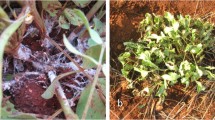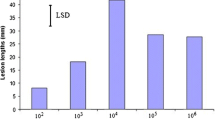Abstract
Fourteen cultivars of lentil (Lens culinaris) were evaluated for their reaction to rhizoctonia seedling blight and root rot caused by Rhizoctonia solani in greenhouse trials, and in field experiments conducted at Brooks, Alberta, Canada in 2003 and 2004. Inoculation produced high levels of disease; stand losses were 56–96% in greenhouse trials and 54–88% in field trials. There were small but consistent differences in disease reaction among the cultivars. Cultivar ‘Laird’ consistently had the highest seedling survival, and ‘Cdc Milestone’, ‘Cdc LeMay’ and ‘Cdc Plato’ were also relatively less susceptible than the other lines. ‘Indianhead’ and ‘Cdc Richlea’ were highly susceptible. Cluster analysis grouped eight relatively less susceptible cultivars into one group and the other six highly susceptible cultivars into another. A correlation between the results of greenhouse and field trials (r = 0.43 — 0.46, P = 0.10) indicated that greenhouse evaluations could provide a useful indication of cultivar performance in response to R. solani in the field.
Zusammenfassung
Die Anfälligkeit von vierzehn Sorten der Linse (Lens culinaris) gegenüber der durch Rhizoctonia solani verursachten Umfall-und Wurzeltöterkrankheit von Keimlingen wurde im Gewächshaus und in Feldversuchen in Brooks, Alberta, Kanada, 2003 und 2004 untersucht. Inokulierte Pflanzen erkrankten schwer; die Verluste in den Beständen erreichten 56–96% im Gewächshaus und 54–88% im Feld. Die Sortenanfälligkeiten zeigten geringe, aber konsistente Unterschiede. Die Keimlinge der Sorte ‘Laird’ hatten die höchsten überlebensraten und ‘Cdc Milestone’, ‘Cdc LeMay’ und ‘Cdc Plato’ waren ebenfalls weniger anfällig als die anderen Sorten. ‘Cdc Milestone’, ‘Cdc LeMay’ und ‘Cdc Plato’ waren hoch anfällig. Acht relativ gering anfällige Sorten wurden mittels einer Clusteranalyse in eine Gruppe eingeordnet und die anderen sechs hochanfälligen Sorten in eine zweite. Die Korrelation zwischen Gewächshaus- und Feldversuchsergebnissen (r = 0.43 — 0.46, P = 0.10) zeigt, dass Gewächshausversuche hilfreiche Informationen über Sortenanfälligkeiten gegenüber R. solani im Feld geben können.
Similar content being viewed by others
Literature
Agriculture and Agri-Food Canada, 2005: Canada: pulse and special crops outlook. [http://www.agr.gc.ca/mad-dam/e/sd2e/2005e/oct2005sc_e.pdf].
Anderson, N.A., 1982: The genetics and pathology of Rhizoc-tonia solani. Annu. Rev. Phytopathol. 20, 329–347.
Bolkan, H.A., W.R.C. Ribeiro, 1985: Anastomosis groups and pathogenicity of Rhizoctonia solani isolates from Brazil. Plant Dis. 69, 599–601.
Chongo, G., S. Banniza, R. A. A. Morrall, 2002: Diseases of lentil in Saskatchewan in 2002. Can. Plant Dis. Surv. 83, 119–120.
Evans, L.E., A.E. Slinkard, 1975: Production of pulse crops in Canada. In: Harapiak, J.T. (ed.): Oilseed and Pulse Crops in Western Canada, a Symposium, pp. 287–324. Western Cooperative Fertilizers Ltd., Calgary, AB, Canada.
Hnatowich, G., 2000: Lentil production. In: Slinkard, A. (ed.): Saskatchewan Pulse Growers Pulse Production Manual, pp. 125–157. Saskatchewan Pulse Growers, Saskatoon, SK, Canada.
Hwang, S.F., 1988: Effects of VA mycorrhizae and metalaxyl on growth of alfalfa seedlings in soils from fields with “alfalfa sickness” in Alberta. Plant Dis. 72, 448–452.
Hwang, S.F., R.J. Howard, K.F. Chang, B. Park, P.A. Burnett, 1994: Etiology and severity of fusarium root rot of lentil in Alberta. Can. J. Plant Pathol. 16, 295–303.
Khare, M.N., 1981: Diseases of lentil. In: Webb, C., G. Hawtin (eds.): Lentils, pp. 163–172. Commonwealth Agricultural Bureaux, Farnham Royal, UK.
Leach, L.D., R.H. Garber, 1970: Control of Rhizoctonia solani. In: Parmeter, J.R. Jr (ed.): Rhizoctonia solani, Biology and Pathology, pp. 189–198. University of California Press, Berkeley, CA, USA.
Mckenzie, D.L., R.A.A. Morrall, 1973: Diseases of three specialty legume crops in Saskatchewan in 1972: field pea, lentil, and fababean. Can. Plant Dis. Surv. 53, 187–190.
Morrall, R.A.A., 2003: Diseases of lentil. In: Bailey, K.L., B.D. Gossen, R.K. Gugel, R.A.A. Morrall, (eds.): Diseases of Field Crops in Canada, pp. 191. Canadian Phytopathological Society, Saskatoon, SK, Canada.
Morrall, R.A.A., D.L. Mckenzie, L.J. Duczek, P.R. Verma, 1972: A qualitative survey of diseases of some specialty crops in Saskatchewan in 1970 and 1971: sunflower, safflower, buckwheat, lentil, mustards and field pea. Can. Plant Dis. Surv. 52, 143–148.
Muyolo, N.G., P.E. Lipps, A.F. Schmitthenner, 1993: Anastomosis grouping and variation in virulence among isolates of Rhizoctonia associated with dry bean and soybean in Ohio and Zaire. Phytopathology 83, 438–444.
Muehlbauer, F.J., J.I. Cubero, R.J. Summerfield, 1985: Lentil (Lens culinaris Medic.). In: Summerfield, R.J., E.H. Roberts (eds.): Grain Legume Crops, pp. 266–311. Collins, London, UK.
Nelson, B., T. Helms, T. Christianson, I. Kural, 1996: Characterization and pathogenicity of Rhizoctonia from soybean. Plant Dis. 80, 74–80.
Ogoshi, A., 1987: Ecology and pathogenicity of anastomosis and intraspecific groups of Rhizoctonia solani Kühn. Annu. Rev. Phytopathol. 25, 125–143.
Saskatchewan Agriculture and Food, 2006: Lentil in Saskatchewan. [http://www.agr.gov.sk.ca/docs/crops/pulses/production_information/Lentil2005.pdf].
Steele, R.G.D., J.H. Torrie, D.A. Dickey, 1997: Principles and Procedures of Statistics: A Biometrical Approach. Third edition. McGraw-Hill, New York, USA.
Swanson, T.A., R.J. Howard, G.H.A. Flores, S.P. Sumar, 1984: Incidence of root rot in pulse crops in southern Alberta, 1978–1983. Can. Plant Dis. Surv. 64, 39–41.
Tekrony, D.M., D.B. Egli, 1991: Relationship of seed vigor to crop yield: A review. Crop Sci. 31, 816–822.
Youngman, V.E., 1967: Lentils — a pulse of the Palouse. Econ. Bot. 22, 135–139.
Author information
Authors and Affiliations
Corresponding author
Rights and permissions
About this article
Cite this article
Wang, H., Chang, K.F., Hwang, S.F. et al. Response of lentil cultivars to rhizoctonia seedling diseases in Canada. J Plant Dis Prot 113, 219–223 (2006). https://doi.org/10.1007/BF03356184
Received:
Accepted:
Published:
Issue Date:
DOI: https://doi.org/10.1007/BF03356184




